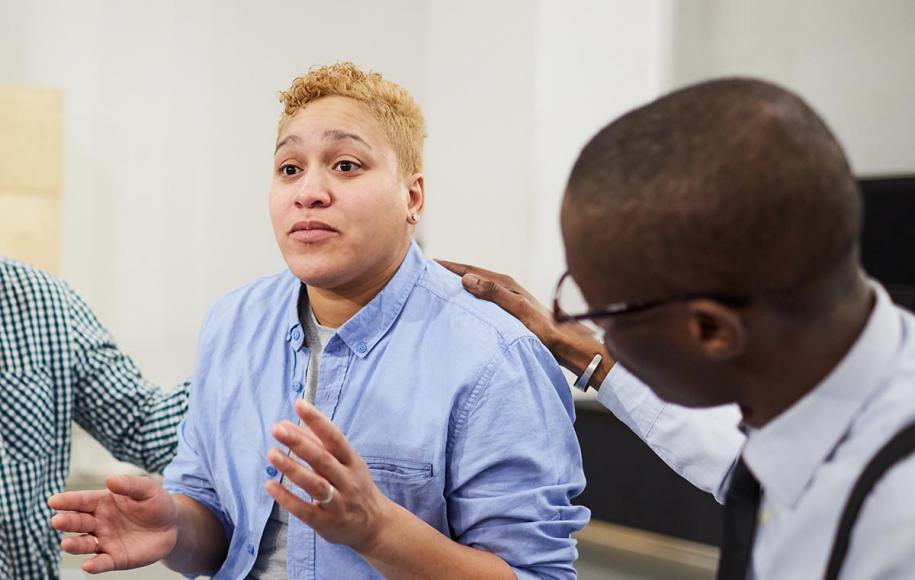
Breadcrumb
- Essential Partners
- Our Impact
- News and Notes
- The Role of Strong Emotions in Dialogue
The Role of Strong Emotions in Dialogue

“How we react to an expression of emotion can invite more, deeper experiences or it can shut people down. Our work is to help people make meaning of the expression. To honor it, listen to it, transform it into something that heals and connects people.”
Participants in our facilitation workshops often ask, with fear and trepidation, what do you do when someone gets really upset?
Emotions in dialogue—as anywhere else—are an expression of meaning. They rise up when something important in the person is moved, an identity, experience, relationship, value, or commitment is engaged. We cannot assume what a given expression of emotion means.
Whether it’s quiet tears or a raised voice, we have to listen carefully, ask questions with care, and witness the person’s expression.
Dialogue creates spaces that are safe enough for participants to express what is most important to them. We invite deeper depths of meaning as we try to get to the “heart of the matter.” Rather than hemming emotion in by reason, we are in fact inviting deeper emotional expressions.
How facilitators—and others—react to an expression of emotion can invite more, deeper experiences or it can shut people down. Our work is to help people make meaning of the expression. To honor it, listen to it, transform it into something that heals and connects people.
Unacknowledged Emotions
When emotions are felt but left unacknowledged by the person feeling them, it can be alienating for everyone involved. When people are unaware of or hijacked by their emotions and not making clear choices, it comes out sideways and can be read as manipulative, uninvested, or insincere.
What we want is for people to be conscious of their emotions, in touch with and informed by them. We want them to make choices about how they’ll manage and express their emotions during a dialogue.
When people suppress a strong emotion, they leave something important unsaid, unrevealed. This is an opportunity missed. It runs against the purposes of dialogue.
As designers of dialogue, we might build in time for reflection after an emotional section to help people acknowledge and make choices about their expression. We might also check in with people during a break if we notice signs of strong emotions—making no assumptions—to see if they need space to process.
Emotions Expressed Without Shape or Purpose
Emotions that are expressed without purpose and shape can overwhelm a person. They can leave people feeling out of control, disassociated, or too vulnerable to continue participating. These types of emotional expressions can also overwhelm other dialogue participants, and leave them feeling threatened and shut down.
We plan for this in preparation by asking questions like, “What will you need to participate fully?” and “How can I support you if things become emotional?” This invites people to plan ahead and might give a facilitator insight into potential pitfalls.
Oftentimes people need support to reframe an expression of emotion, to help them identify the underlying hopes or concerns. If we stay grounded and listen for the need, we can help people make use of their emotions when they themselves cannot.
Witness and Acknowledgement
There is power in simply acknowledging and witnessing people’s emotions. If someone is asking for help, revealing a wound, or sharing what is important to them, sometimes our work is just to witness and acknowledge.
In these cases, the facilitator’s role is to acknowledge the emotions and help people make meaning of them. We do not need to save them, comfort them, or single them out. Sometimes all that is needed is let them know when their time is up, take a breath, and then move on to the next person.
People need to be able to express their emotions openly—if they choose to—in order to have the experience of being seen fully. When we recognize the positive impact that expression can have, then emotions serve the purposes of dialogue by helping to connect, build understanding, and heal relationships.
What dialogue organizers and facilitators need to do is help participants prepare themselves in advance, witness their expressions of emotion, and help them reflect and make meaning from that expression afterwards.
As always, we are here to help you as you lead important conversations in your context. Reach out to schedule a free consultation online.
